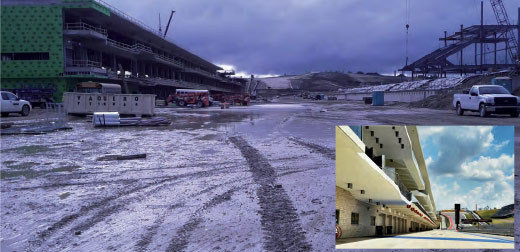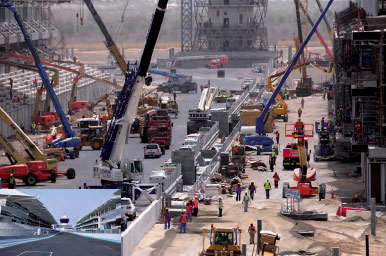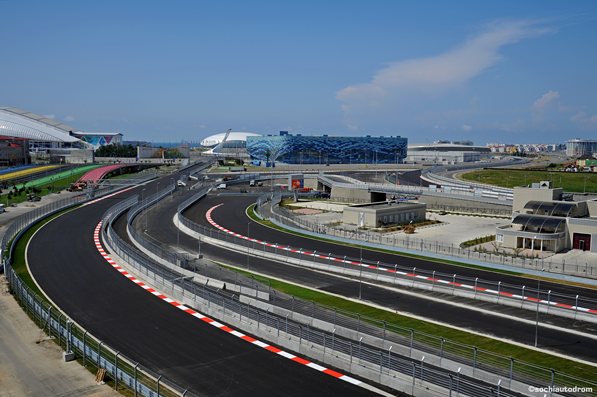Every week numerous magazine features and articles are published about motorsport circuits – mainly Formula 1 circuits, of course, but also smaller tracks, private circuits and testing venues. However, most of these articles will be either descriptions of completed tracks, the events hosted on them, the glamour factor or the hosting countries.
For example, many 2015 headlines will focus on Mexico’s return to the Formula 1 calendar, Baku’s hosting of the European Grand Prix, and Sochi’s second race after a great debut in 2014.
But how did these race venues become a reality? As a designer of all kinds of race tracks, Tilke is keen to explain the development process of such projects and the especially huge effort that is required of venues hosting Formula 1 events.

Above: Circuit of the Americas proved to be one of Tilke’s most demanding projects.
Every Formula 1 and racing project, independent of the country it will take place in, is a challenge. Projects of this size would, for many industries, require a design and construction period of four to five years. However, in the motorsport industry the time taken is generally closer to two to three years.
A race venue hosting a Formula 1 event knows the deadline for completion of the project from the outset, as the date of the first race is specified within the contract. That is the deadline that a circuit’s designers and promoters must work towards. Formula 1 is a multi-million dollar business and not meeting this date is simply not an option.
Imagine if there were delays in the completion of a track and the venue wasn’t ready to host its Formula 1 event. Even if the circuit only needed one more week, this small time extension would influence the whole Formula 1 race calendar, cause irreparable damage to the sport’s image, and result in claims for compensation. This compensation could be substantial, as everything is linked to that race date, from worldwide marketing to television rights, media and advertisements.
Finishing a Formula 1 project also means a venue taking responsibility for its long-term economic viability, as Formula 1 is usually not the only motorsport that a circuit will host. Indeed the cachet of hosting Formula 1 events can also attract other types of business to set up at a facility, among them automotive and leisure companies.
Looking back over Tilke’s 20+ years of experience in constructing race tracks, every project the studio has undertaken has been unique and – during its development – unpredictable. On the one hand, circuit design is always challenging, but on the other, its demanding nature helps create the tension and drive needed to get everyone involved through the long process leading up to a circuit’s completion.
All parameters which make a good Formula 1 team can be transferred to the development of a track project: teamwork; high performance; enthusiasm; pioneering spirit; technology; support; nerves of steel; a vision; flexibility; willingness for compromise; tolerance, and a multicultural understanding.
But above all these factors stands communication.
Communication is of vital importance and a main factor in success in any walk of life.
To illustrate why communication is so critical to circuit design, consider that a race track is a very complex entity, consisting of many, varied, components.
Firstly, a Formula 1 track requires, on average, 140ha (0.54 square miles) of land. This figure, depending on the cut of the plot, can go up to 200ha (0.77 square miles). As a result of this land consumption, new circuits are usually not built on premium plots. A circuit’s location is not necessarily related to the positioning of the site itself, but rather to the soil conditions of the land.
The soil conditions of prospective sites are often quite bad, but due to highly developed engineering techniques, nearly anything is possible. Tracks have already been created in stony desert terrain (Bahrain), on pilings (Shanghai), on sand (Abu Dhabi), and in high earthquake zones (Sochi). Creating circuits in these demanding locations is only possible because of a high level of communication, exchange of knowledge and pioneering spirit.

Above: The start-finish straight at Abu Dhabi during and after construction.
Although the track itself is often considered the centerpiece of a site, there are also essential buildings which have their own unique demands, requiring high levels of functionality to meet the exacting requirements of hosting racing events. This functionality extends to the huge logistical efforts required in hosting race teams, the media, and the machinery needed to run a race event. The infrastructure of the circuit needs to accommodate thousands of people, in terms of space, and also in terms of successfully managing water supplies, sewage, ducting, and the special electronics located all around the track. These elements all need to be planned and constructed. Sometimes, as in the Sochi Olympic project, all these factors have to be implemented into an existing and operational complex.
After mastering the first hurdle of ground conditions and having finalized a design adapted to the topography and local characteristics, further hurdles arise, among them authorities and local standards.
The complex demands of a Formula 1 track are reflected in the complexity of the facilities. A Formula 1 track and its facilities do not usually fit into the building regulations of any country, as they do not fit into the patterns of any building classifications. For example, the pit building is a very special building: it is a garage with a high fire load as there are cars, tires, fuel and computer terminals; and then there are two to three further levels of the building, with thousands of VIP guests on the top floors. Besides the fire safety and emergency egress regulations, building regulations for disabled access have to be adhered to, in parallel to the requirements of FOM and the FIA. In some countries, Formula 1 facilities even require new, customized, building regulations to be specifically written.

Above: Earthquakes in Sochi necessitated special design considerations.
The construction process itself presents a further issue. As a racetrack is a special project, there are usually not many companies local to a site with the necessary experience in circuit construction. This is not such a problem with regard to the construction work itself, but more in regard to time management. It takes time to train people, and more time to discuss and to adapt. Again, communication is essential.
Quality and safety during construction are also key. Sometimes you have to factor in extreme climatic conditions, as found with the Abu Dhabi project, where construction continued in summer time when temperatures exceeded 45°C. A motorsport venue construction project is hard work for everyone involved, but at the end they will have created another iconic highlight in the racing calendar: a prototype, finished just in time, without any testing, which will go from 0 to 100% in one day.
– Article courtesy of PMW Magazine, issue PMW Magazine March – June 2015

Close